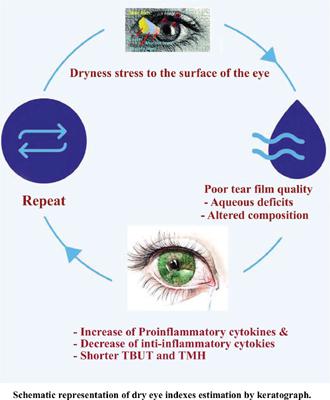Current Proteomics ( IF 0.5 ) Pub Date : 2021-07-31 , DOI: 10.2174/1570164617999201105143947 May N. Al-Muammar 1 , Rania Fahmy 2 , Mona Alonazi 3 , Ramesa Shafi Bhat 4 , Afaf El-Ansary 5

|
Background: Inflammation plays a major role in dry eye diseases and is the prime target in clinical treatments of the disease.
Objective: To determine whether the inflammatory cytokines in the tear film of patients with dry eye correlate with parameters such as Tear Break-Up Time (TBUT) and Tear Meniscus Height (TMH) and could be used together as predictive biomarkers of disease severity.
Methods: This study included 58 eyes (29 female subjects; age, 19–25 years) comprising 20 normal eyes (control), 20 eyes (level 1 dryness), and 18 eyes (level 2 dryness). Dryness level 1 or 2 is keratographic diagnosis according to the tear break-up time cut-off value obtained. After ophthalmic examinations, including determination of non-invasive TBUT average and first second and TMH using Keratograph 4 (to measure dryness level), tears of all participants were collected. Five cytokines, including interleukin 6, 10, 12, interferon-γ, and tumor necrosis factor-α, were measured using ELISA.
Results: Significant changes were observed in all measured cytokines and these changes correlated with eye dryness severity scores. Both groups (levels 1 & 2) showed remarkable changes related to ocular surface alterations in clinical examinations. Significantly, shorter TBUT and TMH were recorded in both groups and were positively correlated with the dryness severity.
Conclusion: Cytokines could be used as predictive markers for pre-clinical diagnosis of dry eye diseases and as prognostic markers to monitor treatment effectiveness.
中文翻译:

炎性细胞因子与健康受试者的角膜曲率计估计的干眼指数相关
背景:炎症在干眼病中起主要作用,是该病临床治疗的主要目标。
目的:确定干眼症患者泪膜中的炎性细胞因子是否与泪液破裂时间 (TBUT) 和泪液半月板高度 (TMH) 等参数相关,并可以一起用作疾病严重程度的预测生物标志物。
方法:本研究包括 58 只眼(29 名女性受试者;年龄,19-25 岁),包括 20 只正常眼(对照)、20 只眼(1 级干燥)和 18 只眼(2 级干燥)。干燥程度 1 或 2 是根据获得的泪液破裂时间截止值进行角膜造影诊断。在眼科检查后,包括使用 Keratograph 4(测量干燥程度)确定无创 TBUT 平均值和第一秒和 TMH,收集所有参与者的眼泪。使用 ELISA 测量了五种细胞因子,包括白细胞介素 6、10、12、干扰素-γ 和肿瘤坏死因子-α。
结果:在所有测量的细胞因子中观察到显着变化,并且这些变化与眼干严重度评分相关。两组(1 级和 2 级)在临床检查中均表现出与眼表改变相关的显着变化。值得注意的是,两组都记录了较短的 TBUT 和 TMH,并且与干燥严重程度呈正相关。
结论:细胞因子可作为干眼病临床前诊断的预测标志物和监测治疗效果的预后标志物。











































 京公网安备 11010802027423号
京公网安备 11010802027423号